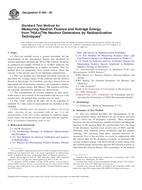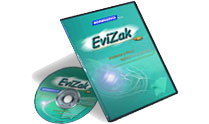Potrebujeme váš súhlas na využitie jednotlivých dát, aby sa vám okrem iného mohli ukazovať informácie týkajúce sa vašich záujmov. Súhlas udelíte kliknutím na tlačidlo „OK“.
ASTM E496-09
Standard Test Method for Measuring Neutron Fluence and Average Energy from 3H(d,n)4He Neutron Generators by Radioactivation Techniques 1
Automaticky preložený názov:
Štandardná skúšobná metóda pre meranie neutrónového Fluence a priemernej energie z 3H ( d , n) 4He neutrónov generátory podľa Radioactivation techniky 1
NORMA vydaná dňa 15.6.2009
Informácie o norme:
Označenie normy: ASTM E496-09
Poznámka: NEPLATNÁ
Dátum vydania normy: 15.6.2009
Kód tovaru: NS-46983
Počet strán: 12
Približná hmotnosť: 36 g (0.08 libier)
Krajina: Americká technická norma
Kategória: Technické normy ASTM
Anotácia textu normy ASTM E496-09 :
Keywords:
14-MeV, DT, neutron activation, neutron generator, neutron metrology, Neutron activation reactions, Neutron flux/fluence, Radioactivation--fast neutron flux, Threshold detectors--14 MeV, Fast neutron flux/fluence, Fluence, ICS Number Code 17.240 (Radiation measurements), 27.120.30 (Fissile materials and nuclear fuel technology)
Doplňujúce informácie
| Significance and Use | ||||||||||||||||||
|
Refer to Practice E 261 for a general discussion of the measurement of fast-neutron fluence rates with threshold detectors. Refer to Test Method E 265 for a general discussion of the measurement of fast-neutron fluence rates by radioactivation of sulfur-32. Reactions used for the activity measurements can be chosen to provide a convenient means for determining the absolute fluence rates of 14-MeV neutrons obtained with 3H(d,n)4He neutron generators over a range of irradiation times from seconds to approximately 100 days. High purity threshold sensors referenced in this test method are readily available. The neutron-energy spectrum must be known in order to measure fast-neutron fluence using a single threshold detector. Neutrons produced by bombarding a tritiated target with deuterons are commonly referred to as 14-MeV neutrons; however, they can have a range of energies depending on: (1) the angle of neutron emission with respect to the deuteron beam, (2) the kinetic energy of the deuterons, and (3) the target thickness. In most available neutron generators of the Cockroft-Walton type, a thick target is used to obtain high-neutron yields. As deuterons penetrate through the surface and move into the bulk of the thick target, they lose energy, and interactions occurring deeper within the target produce neutrons with correspondingly lower energy. Wide variations in neutron energy are not generally encountered in commercially available neutron generators of the Cockroft-Walton type. Figs. 1 and 2 (1) show the variation of the zero degree 3H(d,n)4He neutron production cross section with energy, and clearly indicate that maximum neutron yield is obtained with deuterons having energies near the 107 keV resonance. Since most generators are designed for high yield, the deuteron energy is typically about 200 keV, giving a range of neutron energies from approximately 14 to 15 MeV. The differential center-of-mass cross section is typically parameterized as a summation of Legendre polynomials. Figs. 3 and 4 (1,2) show how the neutron yield varies with the emission angle in the laboratory system. The insert in Fig. 4 shows how the magnitude, A1, of the P1(θ) term, and hence the asymmetry in the differential cross section grows with increasing energy of the incident deuteron. The nonrelativistic kinematics (valid for Ed < 20 MeV) for the 3H(d,n)4He reaction show that:
Fig. 5 (2) shows how the neutron energy depends upon the angle of scattering in the laboratory coordinate system when the incident deuteron has an energy of 150 keV and is incident on a thick and a thin tritiated target. For thick targets, the incident deuteron loses energy as it penetrates the target and produces neutrons of lower energy. A thick target is defined as a target thick enough to completely stop the incident deuteron. The two curves in Fig. 5, for both thick and thin targets, come from different sources. The dashed line calculations come from Ref (3); the solid curve calculations come from Ref (4); and the measured data come from Ref (5). The dash-dot curve and the right-hand axis gives the difference between the calculated neutron energies for thin and thick targets. Computer codes are available to assist in calculating the expected thick and thin target yield and neutron spectrum for various incident deuteron energies (6). The Q-value for the primary 3H(d,n)4He reaction is + 17.59 MeV. When the incident deuteron energy exceeds 3.71 MeV and 4.92 MeV, the break-up reactions 3H(d,np)3H and 3H(d,2n)3He, respectively, become energetically possible. Thus, at high deuteron energies (>3.71 MeV) this reaction is no longer monoenergetic. Monoenergetic neutron beams with energies from about 14.8 to 20.4 MeV can be produced by this reaction at forward laboratory angles (7). It is recommended that the dosimetry sensors be fielded in the exact positions that will be used for the customers of the 14-MeV neutron source. There are a number of factors that can affect the monochromaticity or energy spread of the neutron beam (7,8). These factors include the energy regulation of the incident deuteron energy, energy loss in retaining windows if a gas target is used or energy loss within the target if a solid tritiated target is used, the irradiation geometry, and background neutrons from scattering with the walls and floors within the irradiation chamber.
|
||||||||||||||||||
| 1. Scope | ||||||||||||||||||
|
1.1 This test method covers a general procedure for the measurement of the fast-neutron fluence rate produced by neutron generators utilizing the 3H(d,n)4He reaction. Neutrons so produced are usually referred to as 14-MeV neutrons, but range in energy depending on a number of factors. This test method does not adequately cover fusion sources where the velocity of the plasma may be an important consideration. 1.2 This test method uses threshold activation reactions to determine the average energy of the neutrons and the neutron fluence at that energy. At least three activities, chosen from an appropriate set of dosimetry reactions, are required to characterize the average energy and fluence. The required activities are typically measured by gamma ray spectroscopy. 1.3 The measurement of reaction products in their metastable states is not covered. If the metastable state decays to the ground state, the ground state reaction may be used. 1.4 The values stated in SI units are to be regarded as standard. No other units of measurement are included in this standard. 1.5 This standard does not purport to address all of the safety concerns, if any, associated with its use. It is the responsibility of the user of this standard to establish appropriate safety and health practices and determine the applicability of regulatory limitations prior to use. |
||||||||||||||||||
| 2. Referenced Documents | ||||||||||||||||||
|
||||||||||||||||||
Odporúčame:
EviZak - všetky zákony vrátane ich evidencie na jednom mieste
Poskytovanie aktuálnych informácií o legislatívnych predpisoch vyhlásených v Zbierke zákonov od roku 1945.
Aktualizácia 2x v mesiaci !
Chcete vedieť viac informácii ? Pozrite sa na túto stránku.




 Cookies
Cookies
